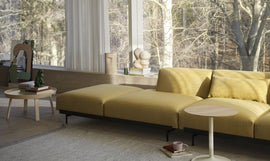Purpose
Many a dining table is repurposed for more than the evening meal—it may be utilised as a homework space, for board or card games, relaxed coffee catchups, or perhaps even a makeshift home office, so it’s important to first consider how the table will function within the home. Entertainers or those who enjoy big family gatherings may need a larger table to accommodate everyone, whereas those who will only use it occasionally won’t need anything too large.
It's about choosing a table that is going to function best for everyone in the home for the majority of the time, not one that’s perfect for Christmas lunch, but otherwise takes up way too much space and is rarely used.
Size
Dining tables can be square, rectangular, round, or even oval—the shape and dimensions of the dining space may determine the right table. Consider where it is positioned within the room and how its placement will affect the flow of traffic through the space. If purchasing a table to match existing chairs, measure the width of the chair and allow enough space between seats—each person will need around 600mm of table space. Chairs with arms are generally wider so reserve these for the end of the table if space is limited.
The table will need to be positioned 1m from the wall or other furniture to allow room for passers by.
Start by measuring your room, then subtract 2m from the length and 2m from the width to arrive at the maximum size table suitable for the space.
The standard height for a chair is 47cm and the average height of a table is 76cm. A gap of 30cm between the bottom of the table and the top of the chair is ideal for comfortable dining and will ensure chairs can be tucked in neatly when not needed.
120cm long table seats 4 people (2 on each side)
180cm long table seats 6 people (3 on each side)
240cm long table seats 8 people (4 on each side)
300cm long table seats 10 people (5 on each side)
360cm long table seats 12 people (6 on each side)
107-122cmD seats 4 people
152cmD seats 6-8 people
By positioning additional seats at either end, seating can be maximised making the space more flexible.
Style
For a seamless look, consider complementing dining chairs with a matching table ensuring the timbers are the same which will allow the eye to perceive both as a set, minimising visual noise to create a calming space.
Alternatively, a table that contrasts the chairs can impart interest and personality into a room, making it a focal point or feature in the room.
Darker colours will draw more attention and may dominate the space, whereas lighter pieces will help the space feel more open.
Materials
Dining tables come in many different materials including timber, laminate, melamine, glass, metal and stone.
Solid wood is a natural choice—it’s durable but imparts warmth and tactility to any room. The wood fibres in hardwood species such as acacia, birch and oak are especially dense which gives these varieties their strength. If treated correctly, they can be resistant to stains and fluids making them a good choice for busy family environments. Hardwoods also age gracefully, achieving a rich patina as the colour deepens over time. Light scratches and marks can be easily repaired, extending longevity and value for money.
Softwoods such as pine and spruce tend to scratch and mark more easily than hardwoods but still contribute a welcoming appeal which works to offset colder materials such as stone benchtops in the kitchen. Timber veneers offer the sophistication of timber at an affordable price—a very thin layer of timber is sealed to particleboard, creating a strong, durable surface. Toxic glues are sometimes used in the adhesion process which is worth keeping in mind as these can leach volatile organic compounds (VOC) into the air.
Laminate is highly resistant to scratches and stains as well as wear and tear, it’s also easy to clean making it perfect for families with small children where the rough and tumble of life is a factor to consider.
Stone tabletops such as marble, quartz composite and cement are durable but porous so they may stain more easily. They can also crack or chip which is difficult to repair. They can be heavy too making them unsuitable in some home applications.
As glass is transparent, it helps to achieve the perception of more room, ideal for small space living where room is tight. It’s impervious to moisture and is easily cleaned but as with stone, glass can chip and crack rendering it permanently damaged.
With so many considerations, we know it can feel overwhelming making a choice. If you would like any assistance in choosing a table for your home, please let us know as we offer a complimentary in-store consultation service and a complete interior design service for in-home appointments.

